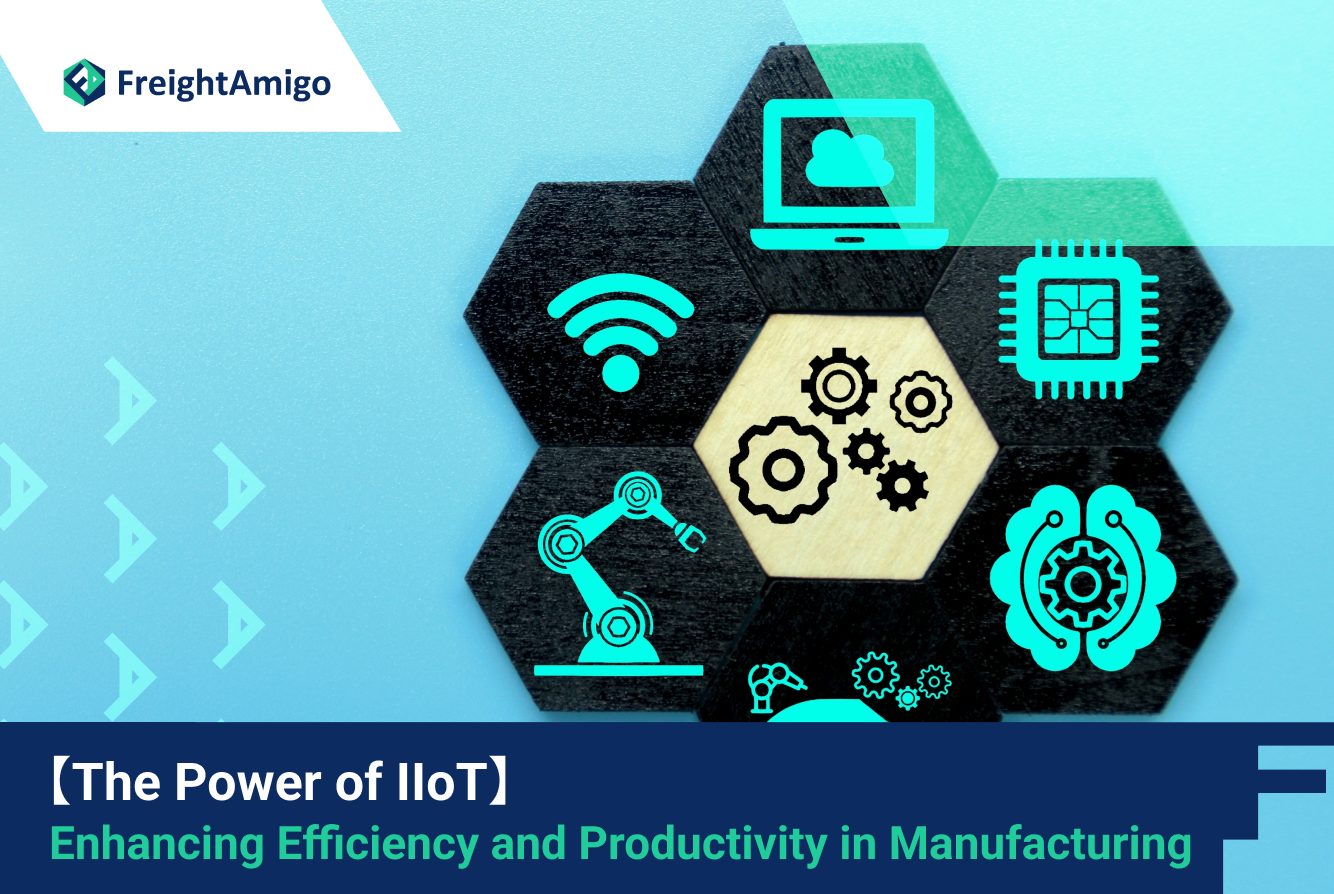Author Name: Tiffany Lee – Marketing Analyst at FreightAmigo
Introduction to IIoT (Industrial Internet of Things)
The Industrial Internet of Things (IIoT) has revolutionized the manufacturing industry by connecting machines, devices, and sensors to the internet, enabling seamless communication and data exchange. With the power of IIoT, manufacturers can gather real-time data, analyze it, and make informed decisions to enhance efficiency and productivity. This article explores the benefits of IIoT in manufacturing, its applications, key components of an IIoT system, challenges in implementation, and future trends.
Want To Compare The Best Express, Air Freight, Sea Freight, Rail Freight & Trucking Rates So As To Have Better Control On Cost?
Benefits of IIoT in Manufacturing
The integration of IIoT in manufacturing brings numerous benefits to the industry. Firstly, it enables predictive maintenance, where machines and equipment can be monitored in real time, detecting potential issues before they cause breakdowns. This proactive approach minimizes downtime, reduces maintenance costs, and ensures continuous production.
Secondly, IIoT facilitates the optimization of production processes. With the ability to collect and analyze vast amounts of data, manufacturers can identify bottlenecks, improve workflows, and optimize resource allocation. This leads to increased operational efficiency, reduced waste, and enhanced overall productivity.
Furthermore, IIoT enables remote monitoring and control of manufacturing operations. By accessing real-time data from anywhere, manufacturers can monitor production lines, adjust settings, and make informed decisions remotely. This flexibility not only improves operational efficiency but also reduces the need for on-site personnel, resulting in cost savings.
IIoT Applications in the Manufacturing Industry
The applications of IIoT in the manufacturing industry are vast and diverse. One significant application is asset tracking and management. By equipping assets, such as raw materials, work-in-progress, and finished goods, with sensors and RFID tags, manufacturers can track their location, condition, and movement throughout the production process. This enables real-time inventory management, reduces the risk of stockouts or excess inventory, and streamlines supply chain operations.
Another application is quality control and assurance. IIoT allows manufacturers to collect data from sensors and cameras installed on production lines, ensuring that products meet specific quality standards. Any deviation from the desired parameters can be detected in real time, triggering immediate corrective actions. This not only improves product quality but also reduces waste and rework, leading to cost savings.
Additionally, IIoT plays a crucial role in environmental monitoring and sustainability. By collecting data on energy consumption, emissions, and resource utilization, manufacturers can identify areas for improvement and implement energy-efficient practices. This not only helps reduce the industry’s environmental footprint but also results in significant cost savings in the long run.
How IIoT Enhances Efficiency and Productivity
IIoT enhances efficiency and productivity in manufacturing through various mechanisms. Firstly, it enables real-time data collection and analysis. By connecting machines, sensors, and devices, manufacturers can gather data on machine performance, production metrics, and environmental conditions. This data can be analyzed to identify patterns, trends, and anomalies, providing valuable insights for process optimization and decision-making.
Secondly, IIoT enables automation and autonomous decision-making. By integrating machines and devices with AI algorithms, manufacturers can automate routine tasks, streamline workflows, and reduce human errors. This not only improves operational efficiency but also frees up human resources to focus on complex problem-solving and innovation.
Moreover, IIoT facilitates intelligent maintenance management. Instead of relying on fixed maintenance schedules, IIoT allows manufacturers to monitor machine health in real time. By analyzing data on factors such as vibration, temperature, and operating conditions, manufacturers can predict maintenance needs accurately. This prevents unexpected breakdowns, reduces downtime, and maximizes machine uptime, resulting in higher productivity.
Key Components of an IIoT System
An IIoT system consists of several key components that work together to enable seamless connectivity and data exchange. Firstly, there are the devices and sensors that collect data from machines, equipment, and the environment. These devices can include temperature sensors, pressure sensors, RFID tags, and cameras. The data collected by these devices is then transmitted to a gateway or edge device.
The gateway or edge device acts as a bridge between the devices/sensors and the cloud or central server. It aggregates, filters, and processes the data before sending it to the cloud. This reduces the amount of data that needs to be transmitted and enables real-time analysis at the edge to ensure timely decision-making.
In the cloud or central server, the data is stored, analyzed, and made accessible to users through dashboards or applications. This is where advanced analytics, machine learning algorithms, and AI come into play. These technologies analyze the data to identify patterns, trends, and anomalies, providing valuable insights for process optimization and predictive maintenance.
Challenges and Considerations in Implementing IIoT in Manufacturing
While the benefits of IIoT in manufacturing are significant, there are also challenges and considerations that need to be addressed for successful implementation. Firstly, security and data privacy are of utmost importance. With the interconnected nature of IIoT, manufacturers need to ensure robust security measures to protect against cyber threats and unauthorized access. This includes encryption, authentication protocols, and secure data storage.
Secondly, interoperability and standardization are essential for seamless connectivity and data exchange. The multitude of devices, sensors, and systems used in manufacturing can hinder interoperability if they do not adhere to common standards. Manufacturers need to consider using open standards and protocols to ensure compatibility and easy integration of various components.
Furthermore, scalability and upgradability should be taken into account. As manufacturing processes evolve and technologies advance, IIoT systems need to be scalable and adaptable to accommodate future growth and changes. This includes the ability to add new devices, upgrade software, and integrate with emerging technologies.
Future Trends and Advancements in IIoT for Manufacturing
The future of IIoT in manufacturing holds exciting possibilities. One trend is the integration of machine learning and AI algorithms into IIoT systems. This will enable real-time decision-making, autonomous optimization of production processes, and continuous learning from data. Manufacturers will be able to achieve higher levels of automation, efficiency, and productivity.
Another trend is the emergence of edge computing. By processing data at the edge devices or gateways, manufacturers can reduce latency, enhance real-time analysis, and minimize the need for constant cloud connectivity. This is particularly beneficial for applications that require immediate responses, such as predictive maintenance or real-time control.
Furthermore, the convergence of IIoT with other emerging technologies, such as blockchain and augmented reality, will unlock new possibilities. Blockchain can enhance transparency, security, and traceability in supply chain management, while augmented reality can enable remote collaboration and training in manufacturing operations.
Conclusion
In conclusion, the power of IIoT in manufacturing is undeniable. By harnessing the capabilities of IIoT, manufacturers can enhance efficiency, optimize production processes, and make data-driven decisions. The benefits of IIoT include predictive maintenance, optimization of workflows, remote monitoring and control, asset tracking, quality control, and environmental sustainability. However, implementing IIoT comes with challenges, such as security, interoperability, and scalability. Looking ahead, the future of IIoT in manufacturing holds promising advancements, including the integration of AI, edge computing, and convergence with other emerging technologies. Manufacturers who embrace IIoT will be well-positioned to thrive in the era of smart manufacturing.
There Are Different Options For Cargo Transportation. If You Want To Choose The Most Convenient And Suitable Solution, It Is Best To Have The Full Support Of Logistics Experts! If You Are Planning To Ship Goods Overseas, Please Go To The FreightAmigo Page For Inquiries.
===
Read More:
【Logistics News】Singapore to Sign Declaration on Green Shipping Corridors
The Power of Innovation: Enhancing Productivity on Your Manufacturing Line through Technology
The Future of Electronics Manufacturing: Embracing Innovation and Automation
【Revolution of Smart Warehouse Inventory】 Leveraging IoT Technologies for Real-time Tracking
Sailing Schedule: Streamlining Logistics Operations for Efficient Shipments
===
If you have any inquiries on logistics/supply chain, feel free to contact FreightAmigo now:
Chat with us online OR
Phone : +852 28121686
WhatsApp: +852 27467829









































